Complete Solutions to Exercises Single Correct of chapter CHEMICAL KINETICS of Class 12 book with complete answers and questions
| Class 12 | CHEMISTRY |
| Chapter | CHEMICAL KINETICS |
| CENGAGE CHEMISTRY | Exercises Single Correct |
| Number Of Questions | 100 |
| Academic Year | 2023-24 |
The rate constant of a reaction with a virus is `3.3xx10^(-4)S^(-1)`. Time required for the virus to become `75%` inactivated is
02:34View SolutionThe rate of the reaction
`2N_(2)O_(5) to 4NO_(2) + O_(2)`
can be written in three ways:
`(-d[N_(2)O_(5)])/(dt)=k[N_(2)O_(5)]`
`(d[NO_(2)])/(dt)=k'[N_(2)O_(5)]`
`(d[O_(2)])/(dt)=k''[N_(2)O_(5)]`
The relationship between k and k′ and between k and k′′ are-04:22View SolutionFor the ideal gaseous reaction, the rate is generally expressed in terms of `(dP)/(dt)` instead of `(dC)/(dt)` or `(dn)/(dt)` (where C=`(n)/(V)` is concentration and n the no. of moles). What is the relation among these three expressions if T and V are constant?
02:43View SolutionA Geigger Muller counter is used to study the radioactive process. In the absence of radioactive substances `A`, it counts `3` disintegration per second (dps). At the start in the presence of `A`, it records `23` dps, and after `10 m` in `13 dps`,
i. What does it count after `20 m` in ?02:15View SolutionWhat is the trend of atomic size on moving from left to right in periodic table?
01:52View Solution`ArarrB, DeltaH= -10 KJ mol^(-1), E_(a(f))=50 KJ mol^(-1)`, then `E_(a)` of `BrarrA` will be
02:27View SolutionFollowing is the graph between `(a-x)` and time `t` for second order reaction `theta=tan^(-1)(0.5)OA=2L mol^(-)`
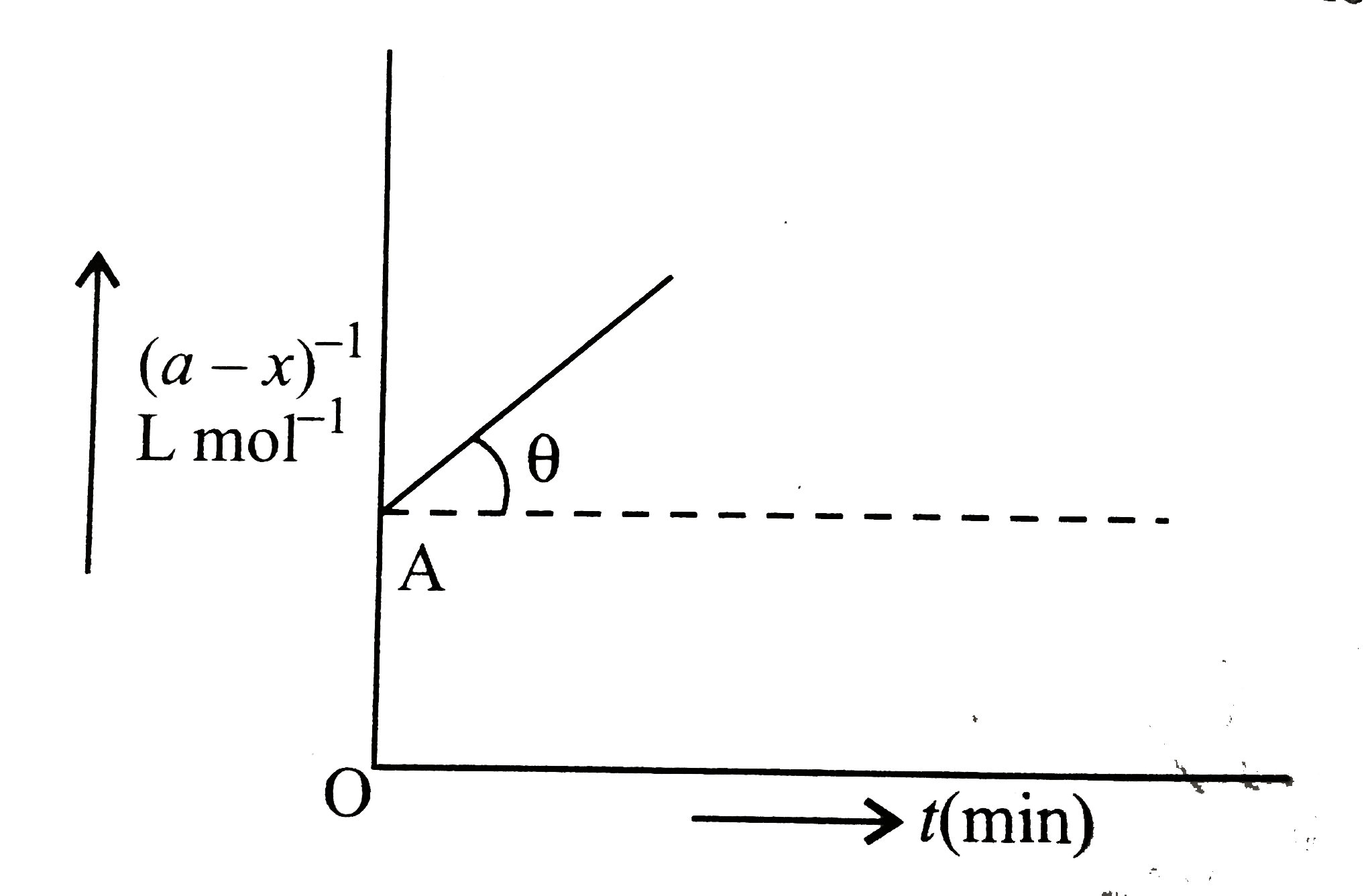
Hence, the rate at the start of the reaction is03:18View SolutionCalculate the rate of reaction for the change 2A→Products, when rate constant of the reaction is `2.1×10^ (−5)` time −1 and [A] 0 =0.2 M.
01:43View Solution
The reaction kinetics can be studied by
02:38View Solution
Half life id independent of the concentration of `A`. After `10 mi n` volume of `N_(2)` gas is `10 L` and after complete reaction is `50 L`. Hence, the rate constant is03:12View Solution`Ararr` Product, `[A]_(0) = 2M`. After `10 min` reaction is `10%` completed. If `(d[A])/(dt) = k[A]`, then `t_(1//2)` is approximately
02:40View SolutionGraph between `log k` and `1//T` [`k` rate constant `(s^(-1))` and `T` and the temperature `(K)`] is a straight line with `OX =5, theta = tan^(-1) (1//2.303)`. Hence `-E_(a)` will be
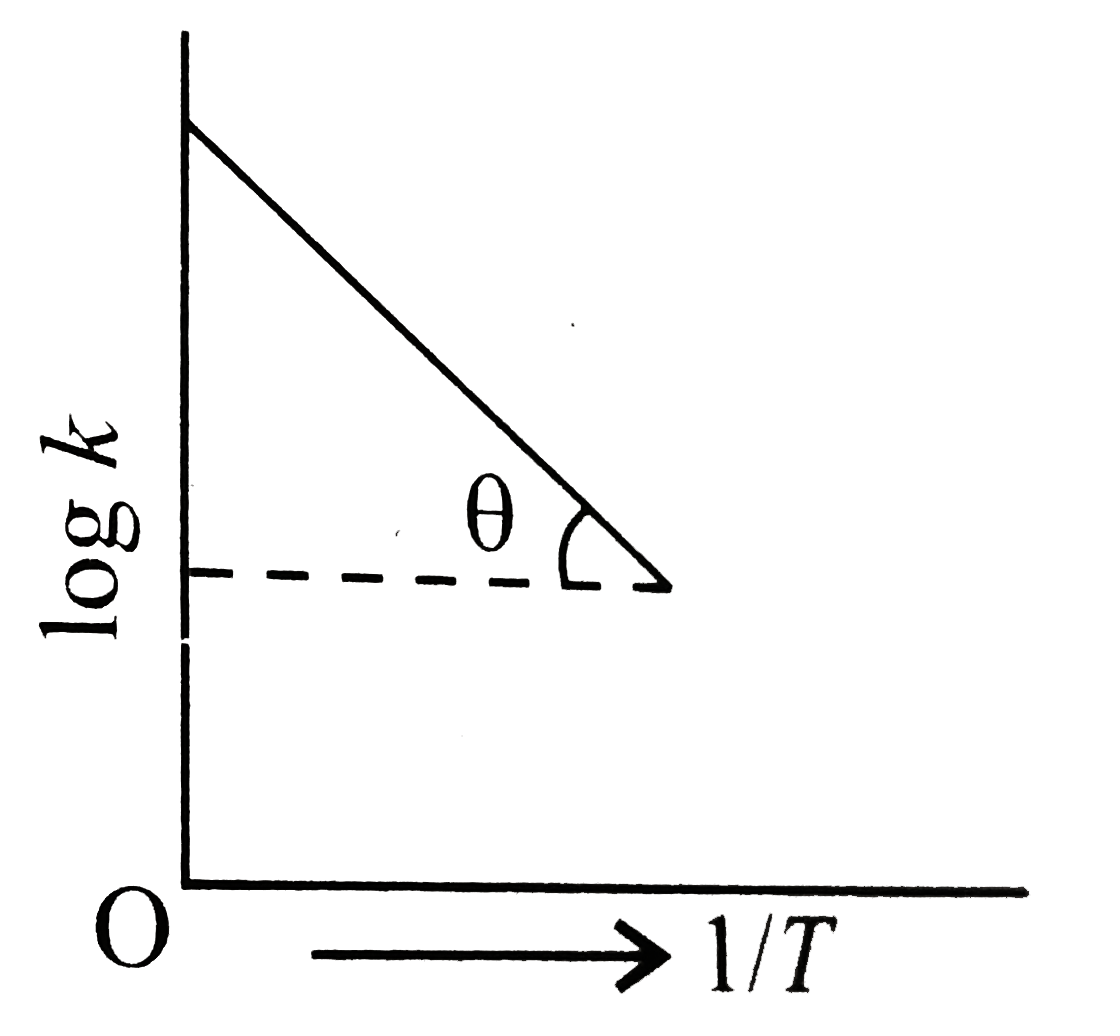 01:35View Solution
01:35View SolutionThe rate of a chemical reaction generally increases rapidly even for small temperature rise because of rapid increases in the
04:08View Solution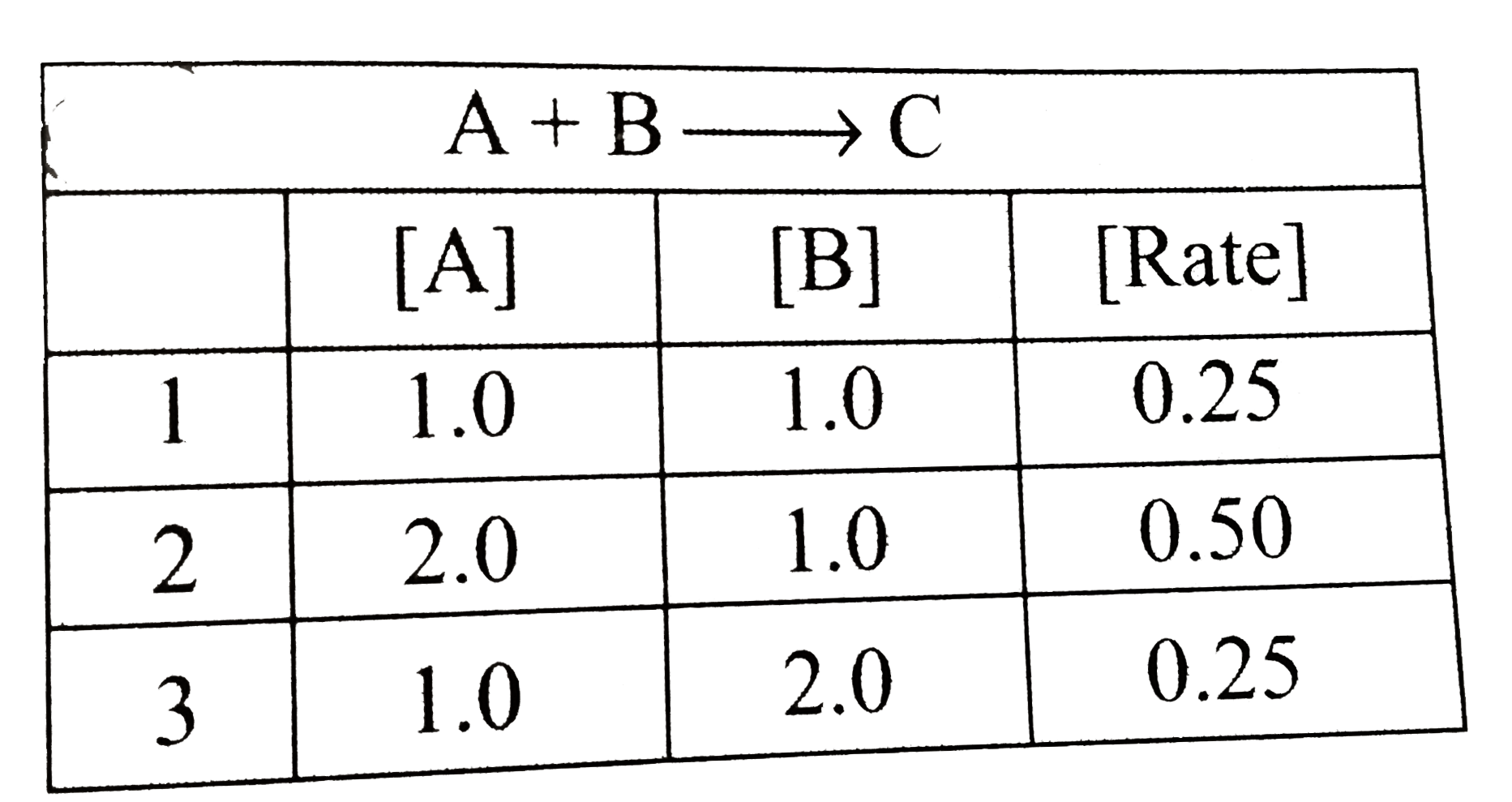
Rate is expressed in `mol L^(-1) min^(-1)`.
In the above reaction, the order is03:50View SolutionRate constant `k = 1.2 xx 10^(3) mol^(-1) L s^(-1)` and `E_(a) = 2.0 xx 10^(2) kJ mol^(-1)`. When `T rarr oo`:
02:46View SolutionThe rate constant of a reaction is `0.0693 min^(-1)`. Starting with `10 mol`, the rate of the reaction after `10 min` is
01:33View SolutionThe graph between concentration `(X)` of the Product and time of the reaction `Ararr B` is of the type `1`. Hence, graph between `-(d[A])/(dt)` and time will be of the type:
 04:10View Solution
04:10View SolutionFollowing is the graph between `log T_(50)` and `log a` (`a =` initial concentration) for a given reaction at `27^(@)C`. Hence order is
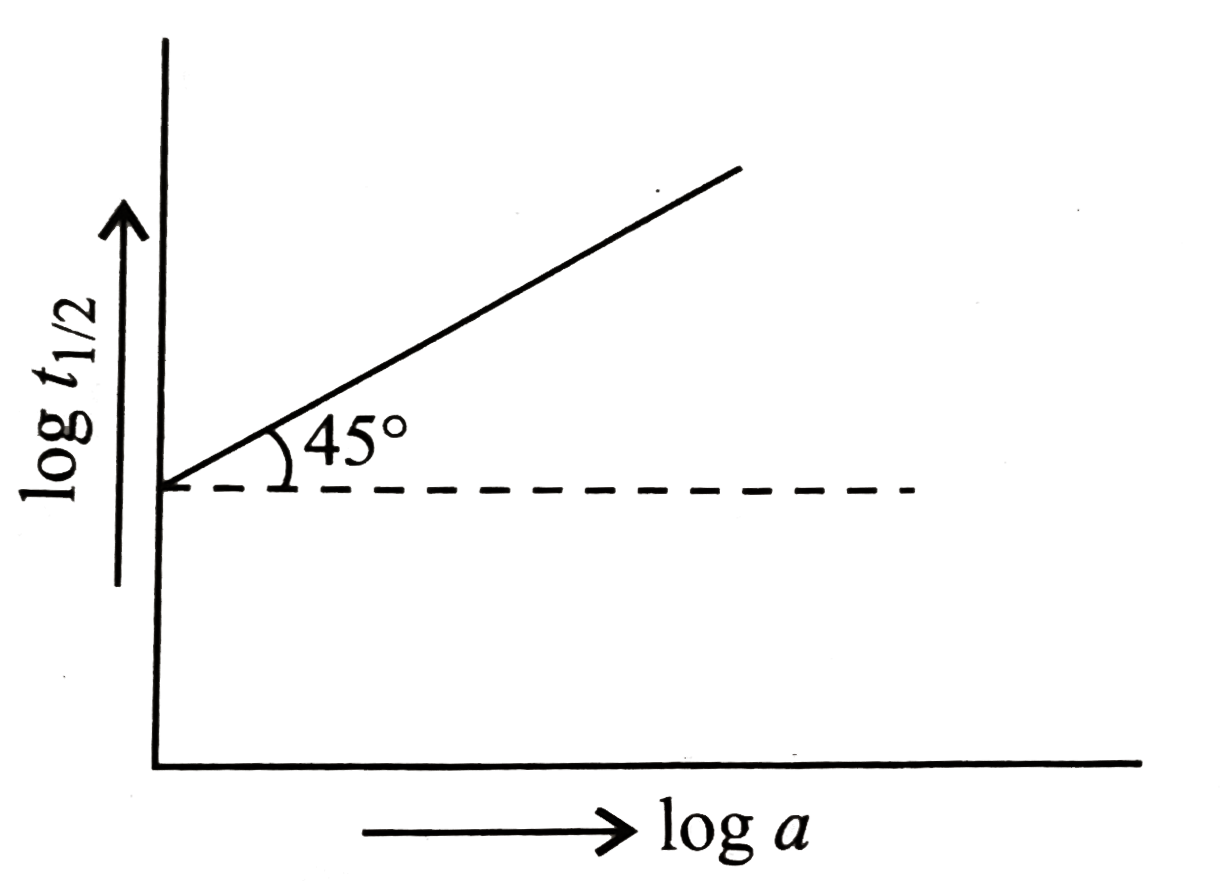 02:18View Solution
02:18View SolutionThe half life of radioactive element is `20 min`. The time interval between the stages of its `33%` and `67%` decay is
02:35View SolutionWhich of the following reaction is not of the first order ?
01:47View SolutionFor the reaction `X+3Y rarrZ`, which form of differential rate law is incorrect?
03:02View Solution`60%` of a first order reaction was completed in `60 min`. The time taken for reactants to decompose to half of their original amount will be
05:43View Solution`70%` of a first order reaction was completed in `70 min`. What is the half life of the reaction?
01:53View Solution`80%` of a fisrt order reaction was completed in `70 min`. How much it will take for `90%` completion of a reaction?
06:24View Solution`90%` of a first order reaction was completed in `100 min`. How much time it will take for `80%` completion of a reaction
05:09View Solution`90%` of a first order reaction was completed in `100 min`.What is the half life of the reaction ?
03:21View SolutionThe hydrolyiss of ester in alkaline medium is a
02:16View SolutionA second order reaction requires `70 min` to change the concentration of reactants form `0.08 M` to `0.01 M`. How much time will require to become `0.04 M` ?
05:18View SolutionThe data for the reaction: `A + B overset(k)rarr C`.
`|{:("Experiment",[A]_(0),[B]_(0),"Initial rate"),(1,0.012,0.035,0.10),(2,0.024,0.070,0.80),(3,0.024,0.035,0.10),(4,0.012,0.070,0.80):}|`
The rate law corresponding to the above data is
(a) Rate `= k[B]^(3)` , (b) Rate `= k[B]^(4)`
( c) Rate `= k[A][B]^(3)` , (d) Rate `= k[A]^(2)[B]^(2)`04:42View SolutionThe temperature at which the average speed of perfect gas molecules is double than at `17^(@)C` is
01:50View SolutionThe temperature at which the average speed of perfect gas molecules is double than at `17^(@)C` is
01:58View SolutionA catalyst lowers the activation energy of a reaction form `20 kJ mol^(-1)` to 10 `kJ mol^(-1)`. The temperature at which the uncatalyzed reaction will have the same rate as that of the catalyzed at `27^(@)C` is
02:28View SolutionThe rate of a reaction increases four-fold when the concentration of reactant is increased `16` times. If the rate of reaction is `4 xx 10^(-6) mol L^(-1) s^(-1)` when the concentration of the reactant is `4 xx 10^(-4) mol L^(-1)`. The rate constant of the reaction will be
01:57View SolutionTwo substances A and B are present such that `[A_(0)]=4[B_(0]` and half-life of A is 5 minutes and that of B is 15 minutes. If they start decaying at the same time following first order kinetics after how much time the concentration of both of them would be same ?
04:14View SolutionA first order reaction: `A rarr` Products and a second order reaction: `2R rarr` Products both have half time of `20 min` when they are carried out taking `4 mol L^(-1)` of their respective reactants. The number of mole per litre of `A` and `R` remaining unreacted after`60 min` form the start of the reaction, respectively, will be
03:05View SolutionThe inverison of cane sugar proceeds with half life of `500 min` at `pH 5` for any concentration of sugar. However, if `pH = 6`, if the half life changes to `50 min`. The rate law expresison for the sugar inverison can be written as
03:36View SolutionIn a reaction carried out at `500 K, 0.001%` of the total number of colliisons are effective. The energy of activation of the reaction is approximately
02:22View SolutionA substance decomposes by following first order kinetics. If 50% of the compound is decomposed in 120 minutes, how long will it take for 90% of the compound to decompose?
01:51View SolutionIf a reaction `A+BrarrC` is exothermic to the extent of `30 KJ mol^(-1)`, the the forward reaction has an activation energy , `70KJ mol^(-1)`, the activation energy for the reverse reaction is
01:18View SolutionThe rate constant, activation energy, and Arrphenius parameter of a chemical reaction are `3.0xx10^(-4)s^(-1), 104.4KJ mol^(-1)`, and `6.0xx10^(14)s^(-1)`, respectively. The value of rate constant as `Trarroo` is
02:25View SolutionThe reaction `A(g) + 2B(g) rarr C(g) + D(g)` is an elementary process. In an experiment involvig this reaction, the initial partial pressure of `A` and `B` are `p_(A) = 0.60 atm` and `p_(B) = 0.80 atm`, respectively. When `p_(C ) = 0.20 atm`, the rate of reaction relative to the initial rate is
02:20View SolutionA catalyst decreases `E_(a)` form `100 KJ mol^(-1)` to `80 KJ mol^(-1)`. At what temperature the rate of reaction in the absence of catalyst at `500 K` will be equal to rate reaction in the presence of catalyst ?
01:40View SolutionWhich of the following graphs is for a second order reaction?
00:53View SolutionThe accompanying figure depicts a change in concentration of species `A` and `B` for the reaction `ArarrB`, as a function of time. The point of inter section of the two curves represents
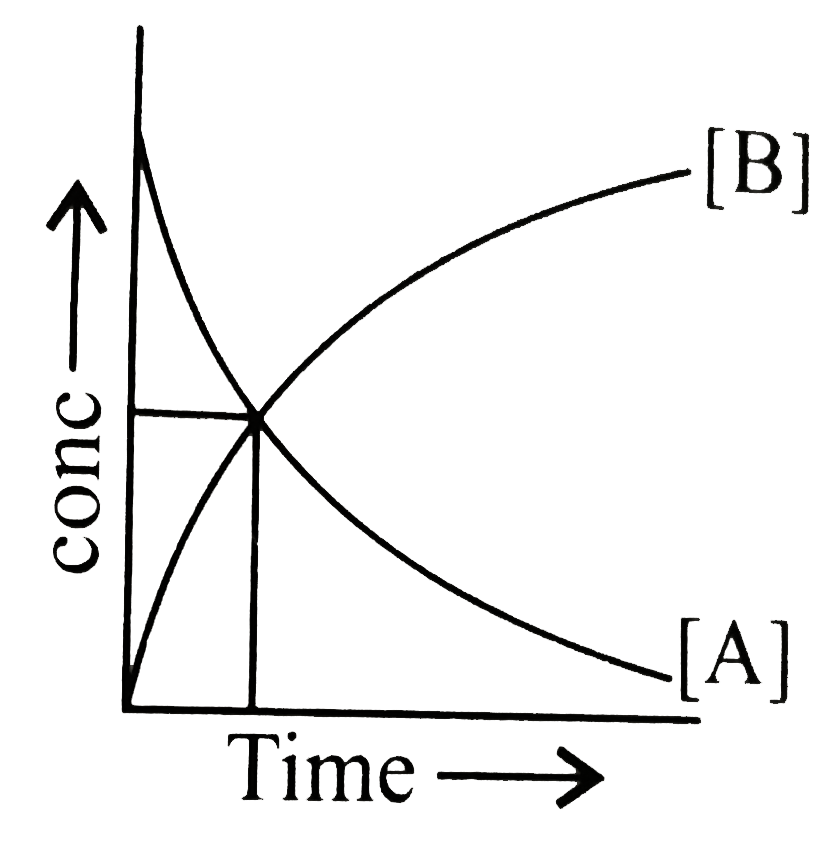 01:42View Solution
01:42View SolutionWhich of the following is correct graph for the reaction?
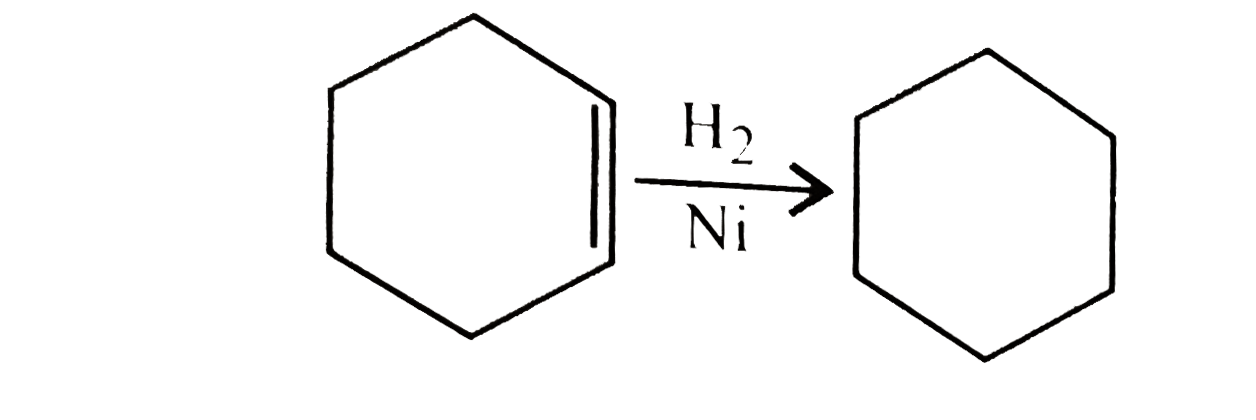 02:53View Solution
02:53View SolutionWhich of the following graphs represents zero order if
`A rarr P` At `t = 0 rArr [A]_(0)` At `t = t rArr [A]_(t)`03:25View SolutionWhich of the following expresisons give the effect of temperature on the rate constant?
01:54View SolutionThe plot og `log k` vs `1//T` helps to calculate
03:00View SolutionFor a first order reaction `t_(0.75)` is `1386 s`. Therefore, the specific rate constant is
03:01View SolutionIn a first order reaction, the concentration of the reactant decreases form `0.8 M` to `0.4 M` in `15 min`. The time taken for the concentration to change form `0.1 M` to `0.025 M` is
03:24View SolutionThe rate equation for the second order reaction `2A+B rarr C` is found to be: `rate = k[A][B]`. The correct statement in relation of this reaction is that
(a) The value of `k` is independent of the initial concentration of `A` and `B`.
(b) `t_(1//2)` is a constant.
(c) The rate of formation of `C` is twice the rate of disappearance of `A`.
(d) The unit of `k` must be `s^(-1)`03:06View SolutionA graph plotted between `log k` versus `1//T` for calculating activation energy is shown by
02:03View SolutionThe potential energy diagram for a reaction `R rarr P` is given below. `Delta H^(ɵ)` of the reaction corresponds to the energy
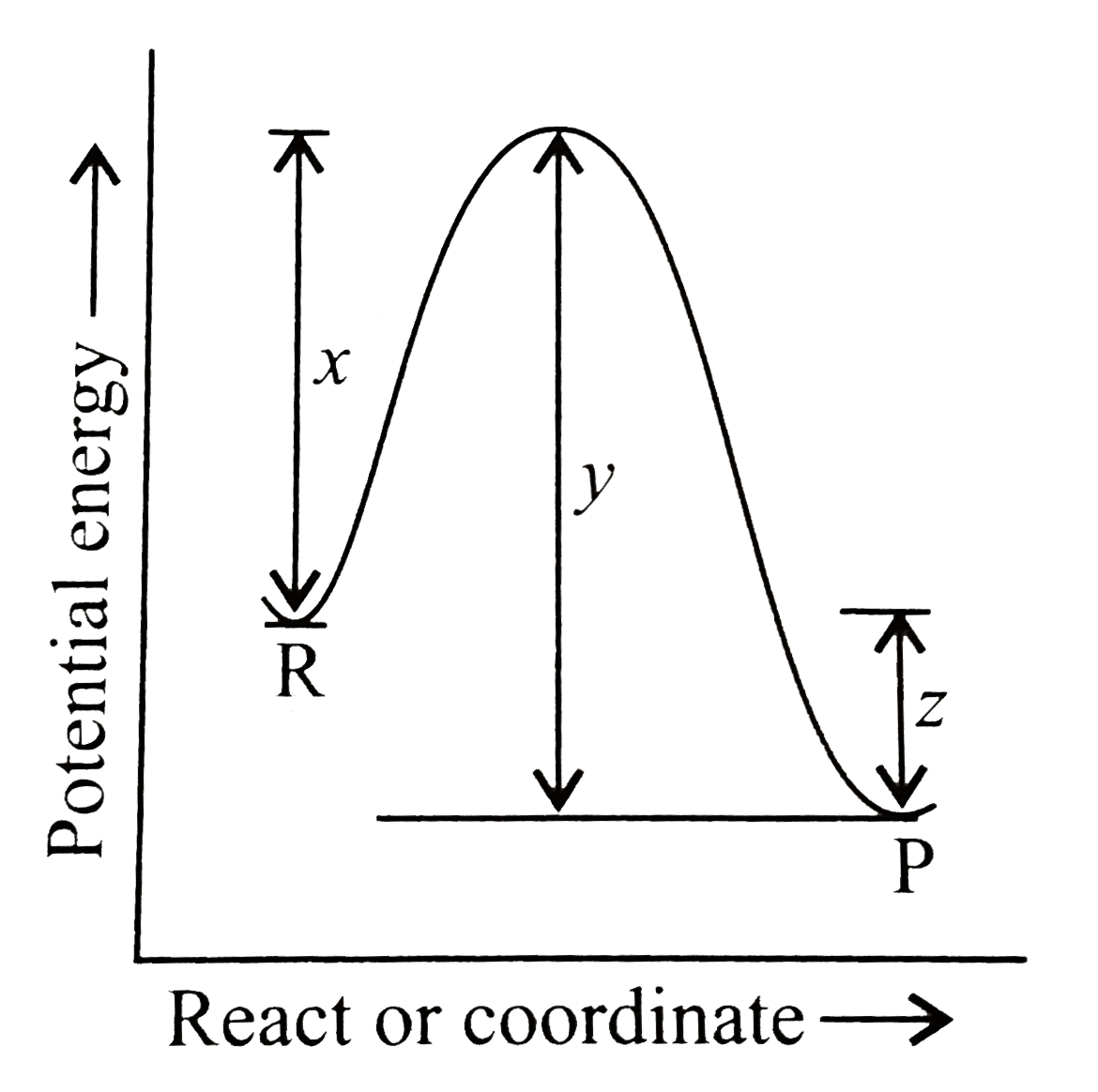 01:37View Solution
01:37View Solutionthe activation energy for a simple chemical reaction `A to B ` is `E_(alpha)` in forward direction .
the activation energy for reverse reaction03:36View Solutionthe reaction `A to B ` follows first order Kinetics the time taken for 0.8 mole of A to produce 0.6 mole of B is 1 H , what is the time taken for the conversion of 0.9 mole of A to 0.675mole of B?
05:24View SolutionWrite the expression for quantum yield in photosynthesis.
01:32View SolutionWhen the rate determined by the change in concentration of two different reactants, then the kinetic equation may be expressed as
03:25View SolutionThe slope of the line graph of `log k` versus `1//T` for the reaction `N_(2)O_(5) rarr2NO_(2) + 1//2O_(2)` is `-5000`.Calculate the energy of activation of the reaction (in `kJ K^(-1) mol^(-1)`).
02:49View SolutionThe inversion of a sugar follows first order rate equation which can be followed by noting the change in the rotation of the plane of polarization of light in the polarimeter. If `r_(oo), r_(f)` and `r_(0)` are the rotations at `t = oo, t = t`, and `t = 0`, then the first order reaction can be written as
(a)`k = (1)/(t)log.(r_(1)-r_(oo))/(r_(o) -r_(oo))`
(b) `k = (1)/(t)ln.(r_(0)-r_(oo))/(r_(t)-r_(o))`
(c) `k = (1)/(t)ln.(r_(oo)-r_(o))/(r_(oo)-r_(t))`
(d)`k = (1)/(t)ln.(r_(oo)-r_(t))/(r_(oo)-r_(0))`03:04View SolutionFor a certain decompoistion, the rate is `0.30 M s^(-1)` when the concentration of the reactant is `0.20 M`. If the reaction is order, the rate (in `M s^(-1)`) when concentration is increased theee times is
02:18View SolutionFor a second order reaction `dx//dt =k(a-x)^(2)`. Its half life periof is
01:53View SolutionFor a chemical reaction, activation energy of reactants depends on ______
02:19View SolutionThe dissociation of nitrogen pentaoxide is a first order reaction. In first `24 min`, `75%` of nitrogen pentaoxide is dissociated. What amount of nitrogen pentaoxide will be left behind after one hour of the start of reaction?
02:50View SolutionIn a certain reaction, `10%` of the reactant decomposes in one hour, `20%` in two hours, `30%` in theee hours, and so on. The dimenison of the velocity constant (rate constant) are
02:06View SolutionThe decompoistion of `H_(2)O_(2)` can be followed by titration with `KMnO_(4)` and is found to be a first order reaction. The rate constant is `4.5 xx 10^(-2)`. In an experiment, the initial titre value as `25 mL`. The titre value will be `5 mL` after a lapse of
02:04View SolutionThe half life of decompoistion of `N_(2)O_(5)` is a first order reaction represented by `N_(2)O_(5)rarrN_(2)O_(4)+1//2O_(2)`
After `15`min the volume of `O_(2)` profuced is `9ml` and at the end of the reaction `35ml`. The rate constant is equal to02:31View SolutionThe rate constant of a reactant is `1.5 xx 10^(-3)` at `25^(@)C` and `2.1 xx 10^(-2)` at `60^(@)C`. The activation energy is
03:15View SolutionIn the reaction `A + B rarr C+D`, the concentration of `A` and `B` are equal and the rate of the reaction is rate `= k[A][B]`. The integrated rate equation for this reaction is
03:13View SolutionIf a graph is plotted between `log (a-x)` and `t`, the slope of the straight line is equal to `-0.03`. The specific reaction rate will be
02:12View SolutionIn the Wilhelmey equation of a first order reaction `c_(t) = c_(0)e^(-kt)`. If the initial concentration `c_(0)` is increased `m` times, then
01:59View SolutionThe mechanism of the reaction
`2NO + O_(2) rarr 2NO_(2)` is
`NO + NO underset(k_(-1))overset(k_(1))hArr N_(2)O_(2) ("fast")`
`N_(2)O_(2) + O_(2) overset(k_(2))rarr 2NO_(2) (slow)`
The rate constant of the reaction is01:35View SolutionTrue statement is
03:30View SolutionIn a second order reaction 20% of a substance is dissociated in 40 min. The time taken by 80% of its dissociation is :
02:53View Solution`t_(1//2) =` constant confirms the first order of the reaction as one `a^(2)t_(1//2) =` constant confirms that the reaction is of
02:51View SolutionCollision theory is applicable to
02:01View SolutionThe wrong statement is
03:37View SolutionWhich of the following will react at the highest rate ?
02:02View SolutionFor a reaction, the rate constant is expressed as `k = Ae^(-40000//T)`. The energy of the activation is
02:26View SolutionA reaction takes place in theee steps: the rate constant are `k_(1), k_(2), and k_(3)`. The overall rate constant `k=(k_(1)k_(3))/(k_(2))`. If `E_(1), E_(2)`, and `E_(3)` (energy of activation) are `60, 30` and `10kJ`, respectively, the overall energy of activation is
02:37View SolutionA reaction rate constant is given by
`k = 1.2 xx 10^(14) e^((-2500)/(RT))s^(-1)`. It means03:26View SolutionFor the reaction `2NO(g) + H_(2)(g) rarr N_(2)O(g) + H_(2)O(g)`, at `900 K` following data are observed.
`{:("Initial pressure of NO (atm)","Initial pressure of" H_(2)o (atm),"Initial rate of pressure decrease" (atm min^(-1))),(0.150,0.40,0.020),(0.075,0.40,0.005),(0.150,0.20,0.010):}`
Find the order of reaction.03:40View SolutionAn exothermic reaction `ArarrB` has an activation energy of `17 kJ` per mole of `A`. The heat of the reaction is `40 kJ`. Calculate the activation energy for the reverse reaction `B rarr A`.
03:06View Solution`k_(34^(@)):k_(35^(@)) lt 1`, then
01:58View SolutionThe compoistion of `N_(2)O_(5)` is a first order reaction represented by: `N_(2)O_(5) rarr N_(2)O_(4) + 1//2O_(2)`.
After `20 min` the volume of `O_(2)` profuced is `10 mL` and at the end of the reaction `40 mL`. The rate constant is equal to01:55View SolutionA catalyst only
02:39View SolutionThe free energy change the due to a reaction is zero when
01:43View SolutionWhat is `Delta H` for the reaction `A + B rarr C` where the mechanism involves several kinetics steps.
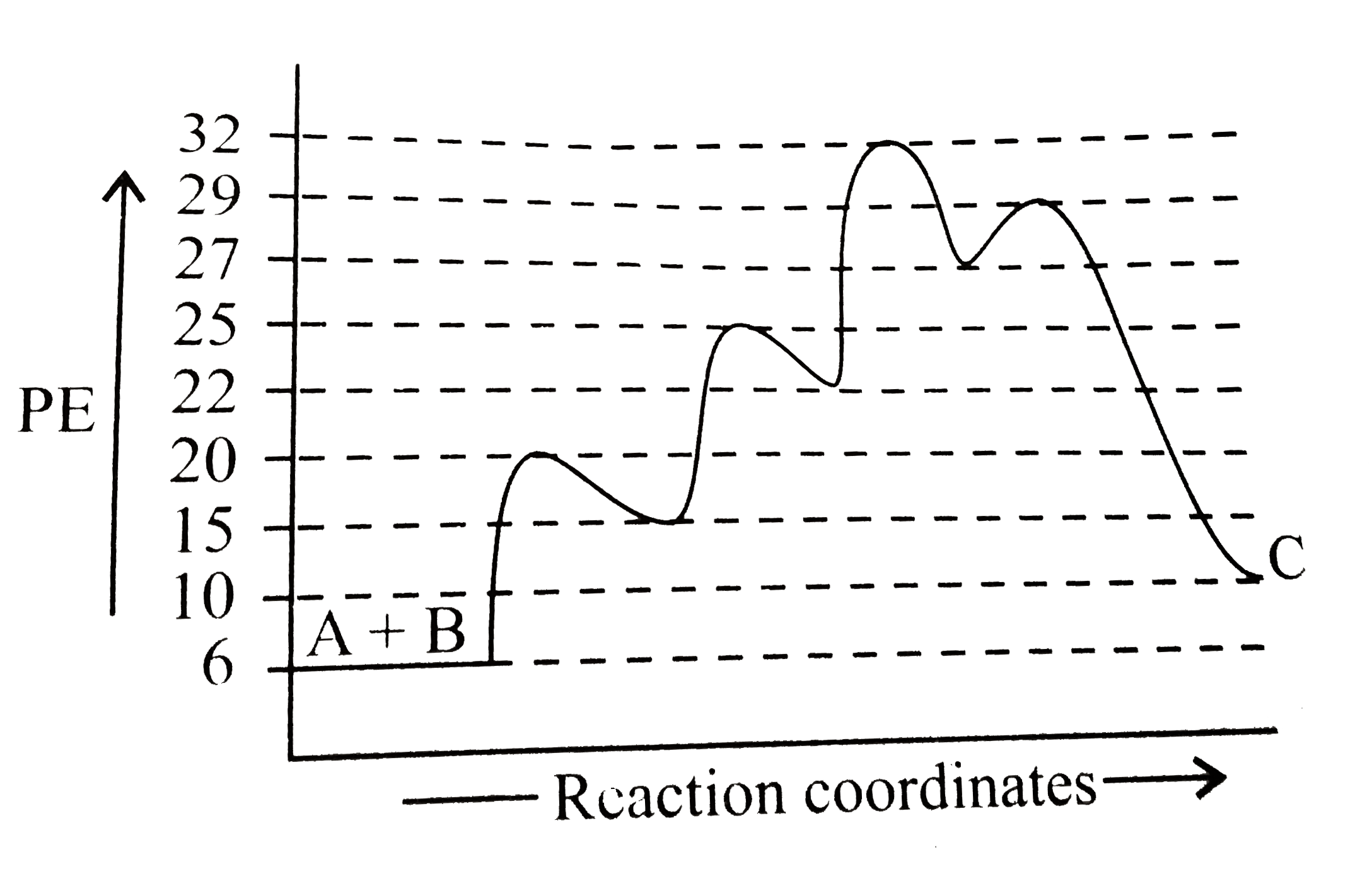
(a) `11 "kcal mol"^(-1)`
(b)`4 "kcal mol"^(-1)`
(c) `5 "kcal mol"^(-1)`
(d) `22 "kcal mol"^(-1)`01:38View SolutionWhat can you say about the existence of `A` if the potential energy diagram for the reaction
`Ararr B` looks line

(a) `A` will exist
(b) `A` will not exist
(c) `B` will not exist
(d) `A` and `B` are in equilibrium01:44View SolutionIn a multistep reaction such as `A + B rarr Q rarr C`. The potential energy diagram is shown below. What is `E_(a)` for the reaction `Q rarr C` ?
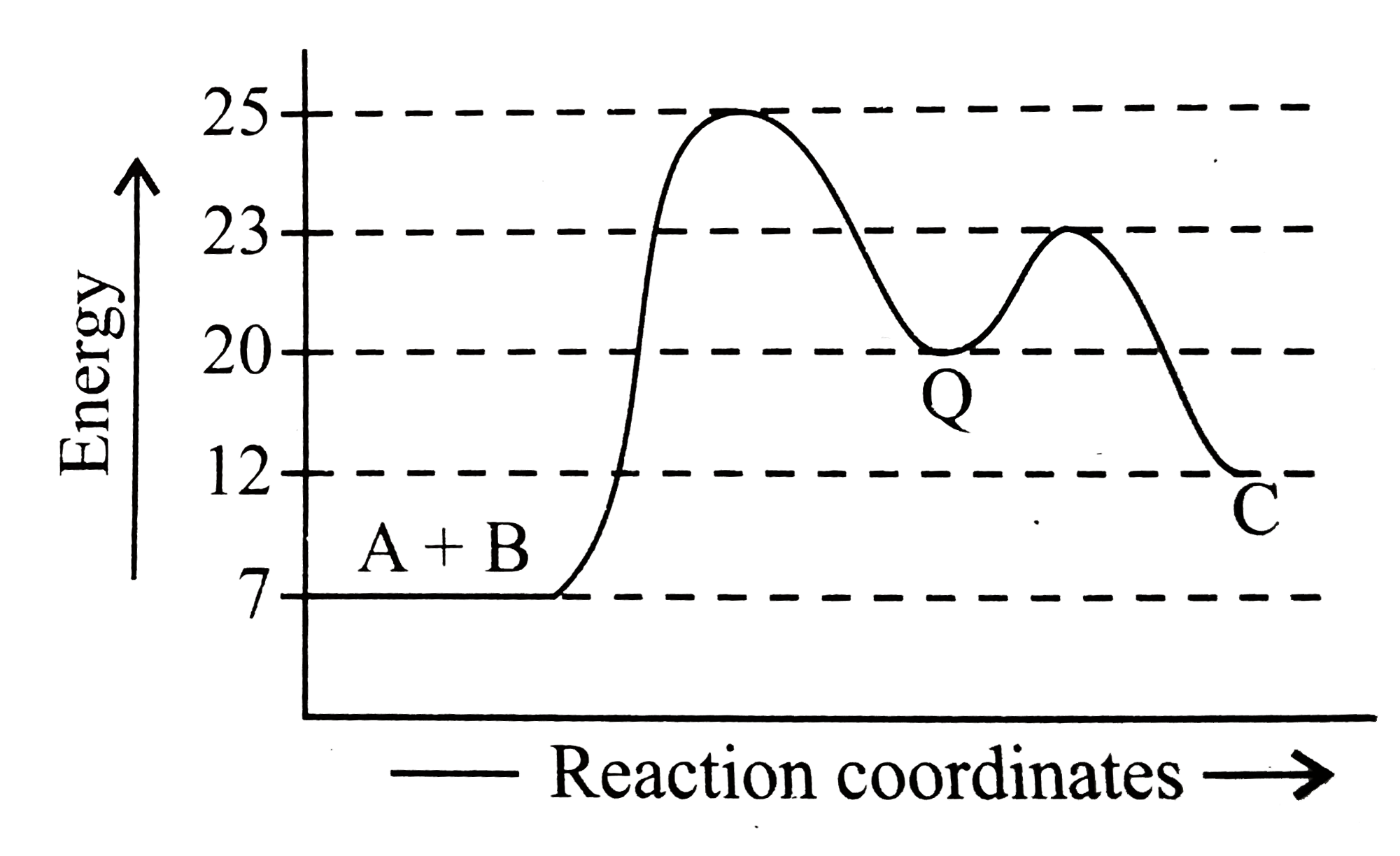
(a)`3 kcal mol^(-1)`
(b)`5 kcal mol^(-1)`
(c) `8 kcal mol^(-1)`
(d) `11 kcal mol^(-1)`02:05View SolutionIn which statement is true ?
02:38View SolutionGiven the following two mechanisms, one with catalyst and the other without catalyst.
(i) `A + B rarr C` (slow)
(ii) `C +B rarr F + A` (fast)
(iii) `B + B rarr F` (slow)
Which mechanism use the catalyst and what is it ?02:51View SolutionThe mechanism for the overall reaction is
`A_(2) + B rarr C`
`A_(2) rarr 2A` (slow)
`2A + B rarr X` (fast)
If a catalyst `D` changes the mechanism to
`A_(2) + D rarr A_(2) D` (slow)
`A_(2) D rArr 2A+D` (fast)
`2A +B rarr C` (fast)
Which is the rate expresison for the reaction with and without a catalyst ?03:48View SolutionWhich of the following statement is correct
02:34View SolutionFor a chemical reaction `2X + Y rarrZ`, the rate of appearance of `Z` is `0.05 mol L^(-1) min^(-1)`. The rate of diappearance of `X` will be
02:17View SolutionA chemical reaction occurs as a result of colliisons between reacting molecules. Therefore, the reaction rate is given by
02:52View SolutionFor profucing effective colliisons, the colliding molecules must have
04:24View SolutionA following mechanism has been proposed for a reaction
`2A +B rarr D rarr E`
`A+ B rarrC+D `(slow)
`A+C rarr E` (fast)
The rate law expression for the reaction by RDS methd is:02:20View SolutionFor a chemical reaction `A rarr B`, it is found that the rate of reaction doubles when the concentration of `A` is increased `4` times. What is the order of reaction ? Suggest the rate law also.
03:32View SolutionFor a hypothetical reaction: `A+B rarr` Products, the rate law is `r = k[A][B]^(0)`. The order of reaction is
01:55View SolutionA hypothetical reaction `A_(2) + B_(2) rarr 2AB` follows the mechanism as given below:
`A_(2) hArr A+A ("fast")`
`A+B_(2) rarr AB+B` (slow)
`A+B rarr AB` (fast)
The order of the overall reaction is02:55View Solution
Exercises Single Correct questions and complete solutions for chapter CHEMICAL KINETICS of CENGAGE CHEMISTRY (ENGLISH) of Class 12
All Exercises from CENGAGE CHEMISTRY Class 12 CHEMISTRY CHEMICAL KINETICS
- Archives Fill In The Blanks
- Archives Integer
- Archives Multiple Correct
- Archives Single Correct
- Archives Subjective
- Archives True/False
- Ex 4.1 (Objective)
- Ex 4.2 (Objective)
- Ex 4.3 (Objective)
- Ex 4.3 More Than One Correct
- Ex4.4 Objective
- Exercises Assertion-Reasoning
- Exercises Fill In The Blanks
- Exercises Integer
- Exercises Linked Comprehension
- Exercises Multiple Correct
- Exercises Single Correct
- Exercises True/False
- Illustration
- Solved Example
